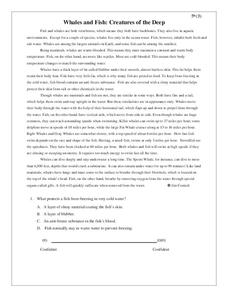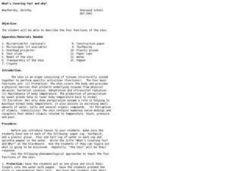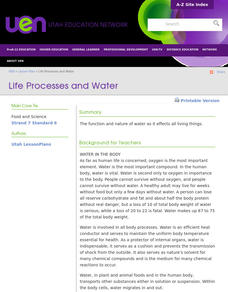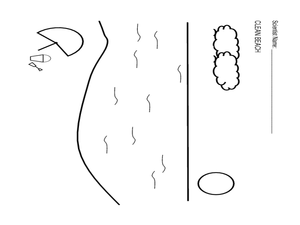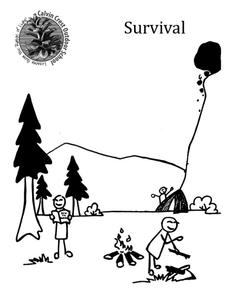Curated OER
Skin and Sports
The topic is protecting our own protective covering: the skin. In particular, the information deals with sweating as a means of temperature regulation and the need to wear clothing appropriate for allowing the process to occur. Learners...
Virginia Department of Education
Thermochemistry: Heat and Chemical Changes
What makes particles attract? Here, learners engage in multiple activities that fully describe colligative properties and allow the ability to critically assess the importance of these properties in daily life. Young chemists...
Outdoor Learning Center
Outdoor Survival
Which of the following can you survive without for the longest time: water, food, or a positive mental attitude? The answer may surprise you. Guide learners of all ages through games, activities, and discussions about surviving in the...
Curated OER
Whales and Fish: Creatures of the Deep
Practice comparing and contrasting details in informational text with a reading passage about whales. It explains the ways that fish and whales are similar, as well as the ways they are different, and specific characteristics of various...
Science Friday
Ugh, a Bug!
Young entomologists familiarize themselves with the physical characteristics of insects. Composed of two activities, each lesson plan involves your scientists tapping into their prior knowledge of bugs and making observations of real...
Curated OER
A Meal of Endurance
Students examine the importance of the nutritional value of explorers' meals. They investigate the concepts of caloric intake vs. caloric expenditure and examine their own nutrition.
Curated OER
A Meal of Endurance
Students evaluate the nutritional value of the explorers' meals. This is done through analyzing caloric intake versus caloric expenditure, describing the trend in diet change that explorers experienced over a two year expedition, ...
Curated OER
Breathing and Holding Your Breath
Five questions are presented and answered as a means of delivering information on the respiratory system. Using red and blue game chips, physiology learners model the movement of blood through the lungs. Groups of learners time how long...
Curated OER
Radical Reptiles
For this reptiles worksheet, students read about reptiles and then answer 10 questions about what they just learned. The answers are on the last page.
Curated OER
What's Covering You? and Why?
Students take a closer look at human skin. In this biology lesson plan, students describe the four functions of the skin as they complete a hands-on activity.
Curated OER
Homeostasis
In this homeostasis activity, students answer twelve questions about positive and negative feedback loops and how they effect homeostasis.
Curated OER
Life Processes and Water
Explain the properties of water. Identify the properties of water that make it a polar molecule Describe hydrogen bonds and how they differ from covalent bonds Discuss the differences between hard water and soft water Compare the heat of...
Curated OER
Fish Hazards
Students study the Pacific salmon and see the different challenges they face. For this environment lesson students complete several activities that show how humans have affected the salmon environment. These activities have varying...
Curated OER
All About Birds
In this birds worksheet, students answer 25 short answer questions about birds. They color and label the different parts of a bird and fill in the correct term given the definitions.
Curated OER
Tale of a Tuna
Junior marine biologists access the International Commission for the Conservation of Atlantic Tunas' data on Atlantic Bluefin Tuna catches. As they analyze the data, they answer three questions. Background information and links to...
NOAA
Vertebrates II
Mammals of the ocean unite! Or not. The 20th installment of a 23-part NOAA Enrichment in Marine sciences and Oceanography (NEMO) program investigates how warm-blooded marine mammals survive in water. In the class activity, learners use...
Calvin Crest Outdoor School
Survival
Equip young campers with important survival knowledge with a set of engaging lessons. Teammates work together to complete three outdoor activities, which include building a shelter, starting a campfire, and finding directions in the...
Primary Resources
Warm Ups & Cool Downs for Children
What makes an effective warm-up and cool-down activity? as well as tips for leading stretches. Find detailed activity plans, as well as tips for leading stretches, for elementary school, tag-based games (including one game called "Toilet...
Curated OER
What is Wind Chill?
Students calculate wind chill using a mathematical formula. In this earth science lesson, students compare the wind chill in Antarctica to that of their local area. They explain how this can lead to hypothermia.
Curated OER
Underwater Animals
Students investigate mammals and blubber. In this science instructional activity abut the sea, students perform an experiment that will help them in discovering how blubber keeps sea mammals warm.
Curated OER
Avoiding Sports Injuries
Students research sports injuries and how to deal with the injury. In this injury prevention lesson, the teacher introduces several exercise risk factors and prevention techniques, then students work in small groups to conduct research...
Curated OER
Feeding: Fast Food
Students calculate the rates of feeding for the average baleen whale, and compare the energy requirements of whales with humans.
Curated OER
Food Safety and Quality Assurance
Students identify and interpret how milk is processed and learn important concepts in food safety and quality assurance. They identify how milk is processed, the importance of food safety, and the quality assurance process. Students also...
Curated OER
Outdoor Survival
Students are introduced to basic outdoor survival concepts. They identify the seven basic needs for survival. Students describe the symptoms and treatment for frostbite and hypothermia. They compare and contrast the value of different...





